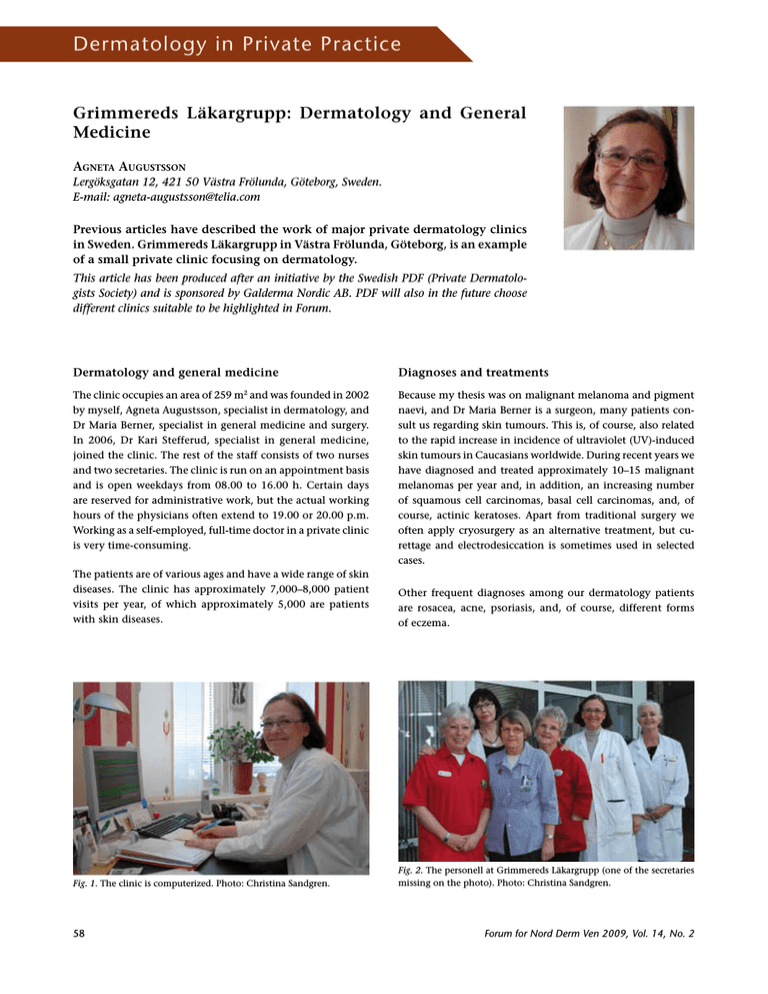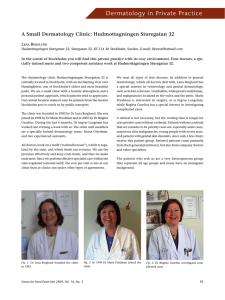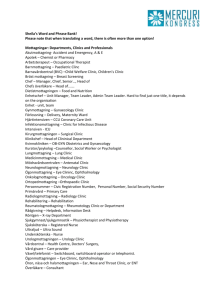Dermatology in Private Practice
advertisement

Dermatology in Private Practice Grimmereds Läkargrupp: Dermatology and General Medicine Agneta Augustsson Lergöksgatan 12, 421 50 Västra Frölunda, Göteborg, Sweden. E-mail: agneta-augustsson@telia.com Previous articles have described the work of major private dermatology clinics in Sweden. Grimmereds Läkargrupp in Västra Frölunda, Göteborg, is an example of a small private clinic focusing on dermatology. This article has been produced after an initiative by the Swedish PDF (Private Dermatologists Society) and is sponsored by Galderma Nordic AB. PDF will also in the future choose different clinics suitable to be highlighted in Forum. Dermatology and general medicine Diagnoses and treatments The clinic occupies an area of 259 m and was founded in 2002 by myself, Agneta Augustsson, specialist in dermatology, and Dr Maria Berner, specialist in general medicine and surgery. In 2006, Dr Kari Stefferud, specialist in general medicine, joined the clinic. The rest of the staff consists of two nurses and two secretaries. The clinic is run on an appointment basis and is open weekdays from 08.00 to 16.00 h. Certain days are reserved for administrative work, but the actual working hours of the physicians often extend to 19.00 or 20.00 p.m. Working as a self-employed, full-time doctor in a private clinic is very time-consuming. Because my thesis was on malignant melanoma and pigment naevi, and Dr Maria Berner is a surgeon, many patients consult us regarding skin tumours. This is, of course, also related to the rapid increase in incidence of ultraviolet (UV)-induced skin tumours in Caucasians worldwide. During recent years we have diagnosed and treated approximately 10–15 malignant melanomas per year and, in addition, an increasing number of squamous cell carcinomas, basal cell carcinomas, and, of course, actinic keratoses. Apart from traditional surgery we often apply cryosurgery as an alternative treatment, but curettage and electrodesiccation is sometimes used in selected cases. 2 The patients are of various ages and have a wide range of skin diseases. The clinic has approximately 7,000–8,000 patient visits per year, of which approximately 5,000 are patients with skin diseases. Other frequent diagnoses among our dermatology patients are rosacea, acne, psoriasis, and, of course, different forms of eczema. Fig. 1. The clinic is computerized. Photo: Christina Sandgren. Fig. 2. The personell at Grimmereds Läkargrupp (one of the secretaries missing on the photo). Photo: Christina Sandgren. 58 Forum for Nord Derm Ven 2009, Vol. 14, No. 2 Agneta Augustsson – Grimmereds Läkargrupp Fig. 3. A glazed atrium is situated close to the clinic. It is used e.g. for educational purposes. Photo: Christina Sandgren. Since several phototherapy units exist in the Göteborg area, we chose not to start our own phototherapy unit. Instead, we refer patients to the unit that is geographically most convenient for them. Suspected contact allergies are investigated through epicutaneous testing. We use the Swedish standard test and also test some patient-related material, such as cosmetics. Each year some 50 patch tests are performed, and of these, more than 50% are positive. A few intracutaneous tests are also performed. Continuing medical education A physician’s continuing professional development is even more important when working in a small unit. In Göteborg, there is a tradition of a weekly conference every Thursday morning at the Department of Dermatology at Sahlgrenska University Hospital. Patients can be brought for consultation and treatment options and investigations are discussed. This is a very beneficial system and fosters good relationships between dermatologists in the private and public sectors. The Swedish Association of Dermatologists in Private Practice (PDF) arranges one or two meetings for its members each year, one of which provides an opportunity for a much appreciated education of our staff. Staff training is otherwise often a neglected area. Because of this we (a few dermatologists in private practice in Central and Western Sweden) formed a Forum for Nord Derm Ven 2009, Vol. 14, No. 2 small group more than ten years ago, which meets once a year together with our staff in order to learn from each other and to exchange experiences. Since this arrangement has been very successful, our clinic has taken the initiative to form a group to promote similar co-operation with some private dermatology clinics in Skåne and Östergötland. In order to update my own knowledge and to continue to learn, I try to attend a major international dermatology congress each year, or at least every other year. Of course, I try to participate in the education provided in Sweden, e.g. by the Swedish Society for Dermatology and Venereology (SSDV). Financing Dr Berner and I work with a special permit (“etableringsrätt”) and we are paid by the commune according to a tariff, which is regulated by the state (“nationella taxan”). So far, these permits to work as a doctor and to be refunded according to the national tariff have been lifelong, but major changes can now be expected within private healthcare. Nothing can be taken for granted any more, and safety and continuity are unfortunately not a priority. Dr Stefferud is also refunded through the national tariff, but she has a temporary agreement with the commune until spring 2010. Her agreement will not be renewed due to the “Fritt vårdval” reform, which will be implemented within general medicine in the county of Västra Götaland in autumn 2009. Dermatology in Private Practice 59 Agneta Augustsson – Grimmereds Läkargrupp The addition of aesthetic dermatology to our practice has made our work as dermatologists more complete and even more enjoyable. Over the years it has been difficult to make patients realize the importance of sun avoidance in order to reduce the risk of different forms of skin cancer. However, it is easier to motivate a patient who has paid for a skin rejuvenation to take care in the sun. Perhaps this could be an incentive to create a better climate of co-operation between skin care and dermatology healthcare in the future. Fig. 4. A patient with a scar on his forehead is treated with fractional laser (1540). Photo: Christina Sandgren. Aesthetic dermatology and skin care In 2006 we added some aesthetic dermatology to our healthcare activities. In aesthetic dermatology the patient pays the whole cost of the treatment. We decided to do this for two reasons: (i) to provide security in case we are unable to work on a national tariff basis in the future; and (ii) to give us the opportunity to offer our patients a total concept. We work with intensive pulsed light (IPL) and laser. We also sell skin care products, including sunscreens. The IPL is used for hair removal and for treatment of superficial blood vessels and pigmented lesions. By treating the whole face or the upper chest with IPL, collagen production is stimulated and thus so-called skin rejuvenation is brought about. Our clinic has a Neodym YAG laser 1064. This has an internal cooling system, which means that superficial blood vessels on the legs, up to 5 mm in diameter, can be treated with a lasting result. The latest machine is a fractional laser (1540). With this laser we can treat wrinkles, but also conditions we have not been able to treat previously, such as acne scars, some scars after burns, striae and even melasma. Keloids do not respond to this treatment, however. 60 Dermatology in Private Practice Epidu Nyhet! o® 60 gram Med Epiduo blir det enklare att behandla akne. Epiduo är en antibiotikafri lokal kombinations­ behandling som har effekt redan efter en vecka på inflammatoriska lesioner. Behandlingen är enkel, gelen appliceras en gång om dagen och tolereras i allmänhet väl.1 Referenser: 1) www.fass.se SEepi0905/01 Our skin care products are based on the alpha-hydroxy acids (AHA) and polyhydroxy acids (PHA). The products are of American origin and are the result of research by two professors of dermatology. They have scientifically demonstrated anti-ageing effects and, in addition, good results on other conditions such as rhagades of the palms and soles, keratosis pilaris, and dry skin in general. We can provide our acne patients with evaluation of suitable foundations, concealers, and emollients as a complement to the medical treatment. Peeling treatments with AHA acids are performed at the clinic, both separately and as a part of skin rejuvenation. Antibiotikafri kombinations­ behandling mot akne Namn: Epiduo® 0,1% / 2,5% gel. Beredningsform: Gel. Verksamma beståndsdelar: 1 g gel innehåller: Adapalen 1 mg (0,1%) och bensoylperoxid 25 mg (2,5%). Grupp och indikation: Medel mot akne för utvärtes bruk, D10AD53. För kutan behandling av acne vulgaris när komedoner, papler och pustler förekommer. Varningar och försiktighetsmått: Epiduo gel ska inte appliceras på skadad hud, varken på öppna sår (skärsår eller skrapsår) eller på eksem. Bör inte komma i kontakt med ögon, mun, näsborrar eller slemhinnor. Om gelen kommer i ögat, skölj omedelbart med varmt vatten. Den här produkten innehåller propylenglykol (E1520) som kan orsaka hud­ irritation. Om en reaktion uppstår som tyder på känslighet mot något av innehålls­ ämnena, ska användningen av Epiduo avbrytas. Överdriven exponering för solljus eller UV­strålning ska undvikas. Epiduo bör inte komma i kontakt med färgat material såsom hår och färgade tyger, eftersom gelen kan orsaka blekning och missfärgning. Galderma Nordic AB. Box 15028 Informationen sammanställdes: 2009­03­01. Läkemedlet är receptbelagt. Pris: 30 g; 167 15 Bromma. Tel 08­564 355 40 189,50 kr. 60 g; 335 kr. Mer produktinformation finns på www.fass.se Fax 08­564 355 49. www.galderma.se Forum for Nord Derm Ven 2009, Vol. 14, No. 2


